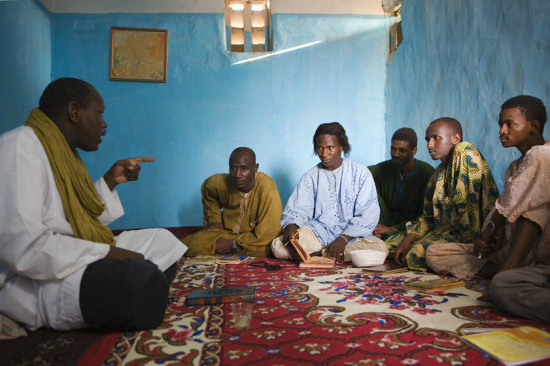Mali in the rainy season has its own rhythm, especially in the South: long days under heavy skies anticipating rain; moments when it comes so powerfully the world seems ready to end. Afterwards, a peculiar freshness and coolness, and new brown streams gurgling everywhere. With Ramadan coming soon, that rhythm will be syncopated, the regular beat of fasting, praying, and feasting punctuated by the shifting rhythm of the storms. Over the last few weeks, the rhythm of Mali’s ongoing political crisis had slowed to a painful shuffle, until last week’s assaults on the tombs of saints, scholars and prominent ancestors in Timbuktu punctuated a long, leaden moment.
Armed with pick-axes and hoes, the Salafists of Ansar Dine made easy work of adobe tombs in “the city of 333 saints,” just as they make easy headlines with their cynical and violent distortions of Islam. In a radio interview, the scion of one of Timbuktu’s prominent families—recognized locally as descendants of the Prophet—was virtually in tears talking about what had been done to the city and to his father’s tomb. Outsiders wailed and gnashed their teeth. Foreign journalists were taxed as sensationalists for covering—or creating—the story, but it might be wiser to appreciate their efforts to keep the crisis visible. From the Hague—hardly the city of saints—came dark rumblings about the International Criminal Court, which does not practice hudud punishments but does take seriously crimes against humanity—and against UNESCO world heritage sites.
We’re a long way from the African Renaissance. That idea, dear to the heart of former President of South Africa Thabo Mbeki among many others, largely propelled the revival of efforts to preserve Timbuktu’s manuscript tradition. South Africa took the lead in rebuilding the Ahmed Baba center, investing in preservation and cataloguing, and committing to the hard work of protecting a fragile and diffuse written heritage. The South Africans were far from being the only actors on the scene. Since the late 1990s, their interest—and that of others, including American literary scholar Henry Louis “Skip” Gates—had generated a market for manuscripts and a series of private ventures that was symptomatic of the broader moment in Malian political life, in which everyone was trying to get a piece of something. Still, the dedication and the good intentions of the scholars are admirable, indeed beyond reproach. Early in the current crisis, many African researchers expressed their concern over the danger the conflict in the North posed to the region’s intellectual treasures. They knew what was at stake. Over the last decade or more, Malians, Nigeriens, Senegalese, South Africans, and Canadians had begun to circumscribe and engage with a polycentric and dynamic Sahelian Muslim intellectual tradition that extends far beyond the city of Timbuktu. They revived an initiative that had begun nearly fifty years ago and some of their work—likeBruce Hall’s intellectual history of the Niger Bend—already helps us to understand what is going on in Mali today. At the moment, tombs and everyday people rather than manuscripts are the targets of Ansar Dine’s grandstanding, but those invaluable papers can easily be sold or simply dispersed. Although reports on the state of the collections are dire, the heir of at least one of the richest private collections reportedly salvaged it well before the city fell to Islamists and Tuareg separatists in April. There’s hope.
If the manuscripts are imperiled, the human tradition is probably less fragile. After all, a good deal of what we know about the history of the city and the region in which it sits comes from what its native sons—including Ahmed Baba—wrote in the wake of another invasion from the north, the Moroccan conquest of 1591. Little solace in the present moment, I know, but take a look at Alexandra Huddleston’s exquisite short film composed of images of everyday learning in contemporary Timbuktu. That pedagogy is a living, spoken one, and it will return. Some 300,000 Malians have fled the North in the last few months, and the coming holy month will surely be a bitter one for them and their compatriots. Perhaps history offers some small solace. Timbuktu’s most celebrated exile, the sixteenth-century scholar Ahmed Baba, who was held hostage in Morocco for many long years, eventually returned to the city of saints. By the same token, the power of the “African Renaissance,” going back to the West Indian E. W. Blyden and the South African Pixley Seme, lies in its endurance.
Crossposted from Africa is a Country.


